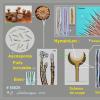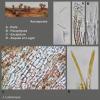
14-07-2015 15:21
Roland LabbéBonjour !Voici un Brunnipila clandestina probable.

14-07-2015 11:38
Marja PennanenHello,these strange for me discs are about 0,1-0,2

10-07-2015 19:34
Joaquin MartinHolaOrbilia encontrada en bosque de ribera, sobre

12-07-2015 22:37
Salvador TelloHola a todos, siempre me surgen dudas de que serí

07-07-2015 13:30
Gernot FriebesHi, here is the second fungus. Again a short descr

12-07-2015 11:11
En madera de Rosacea (melocotonero)Mer parecio por

12-07-2015 21:45
Marcus YeoThis fungus was growing on dead stems of Sedum (Rh

11-07-2015 16:54
Marja PennanenHello,once again Raitviirs study gave me no answer

12-07-2015 00:05
 Nedim Jukic
Nedim Jukic
This one from the same locality as the previous on
Brunnipila clandestina
Roland Labbé,
14-07-2015 15:21
Voici un Brunnipila clandestina probable.
Merci ne nous aider à son identification !
Roland
Données :
Ascome jusqu'à 0,5 mm de largeur x 0,72 mm de hauteur, discoïde, stipité, densément couvert de poils en stries longitudinales
Hyménophore lisse, crème à ochracé
Substrat : vieille tige d'herbacée de platebande
Spores étroitement fusoïdes-cylindriques, lisses, non septées, avec 2 petites guttules polai-res, à contenu hyalin ou trouble, (8,6)9,2-10,5(10,6) x (1,6)1,8-2,1(2,2) µm, 9,7 x 1,9 µm en mo-yenne, Q = (4,5)4,52-5,6(6,2), Q moyen = 5
Asques cylindriques, à 8 spores bisériés, sans crochet basal, avec appareil apical amyloïde et contenu dextrinoïde, 43,8-48,5 x 3,5-4,3 µm, 45,8 x 4 µm en moyenne
Paraphyses lancéolées, à contenu huileux finement granuleux jaunâtre (100%), et petites granules (bulles) plus foncées (environ 10-20% ?), 61,6-73,87 x 3,2-3,89 µm, 67,7 x 3,5 µm en moyenne, dépassant les asques de 17,5-21,1 µm
Poils de la paroi externe cylindriques, obtus vers l'apex, à paroi jusqu'à 0,44 µm d'épaisseur, avec quelques septa, densément verruqueux, fortement incrustés à l'apex, brun ochracé, (87,6) 95-133,3 (134,4) x 3,1-3,4 µm
Medulla en textura porrecta, formé d'hyphes cylindriques, à paroi jusqu'à 0,7 µm septées, 1,58-2,34 µm de diam.
Excipulum ectal en textura prismatica, formé de cellules parallèles ascendantes, rectangu-laires-obtuses, à paroi jusqu'à 1,8 µm d'épaisseur, hyalines à brunâtres, (7,9) 8,9-13,7 (14,6) x (3,4) 4-5,9 (6,5) µm, 11 x 5 µm en moyenne
Hans-Otto Baral,
14-07-2015 17:12

Re : Brunnipila clandestina
Yes, this is clearly B. clandestina. Important is that the asci are without croziers, which is quite well seen on your plate.
Roland Labbé,
14-07-2015 17:42
Re : Brunnipila clandestina
Merci, Hans !
Jules, Jacqueline & Roland
Jules, Jacqueline & Roland

